Written by Hugo Salinas Price
 The inevitable rise of gold and silver is close and thus, the end of the world’s present monetary system is already taking place. The clearest symptom is the frantic bellicosity of the US, propelled by the perception on the part of those who run the US, that the US is losing influence in the world, and that their deep-seated objective for control of the whole world is slipping out of their hands. The end of the dollar as the basis of the international monetary system means the end of the US as we have known it.
The inevitable rise of gold and silver is close and thus, the end of the world’s present monetary system is already taking place. The clearest symptom is the frantic bellicosity of the US, propelled by the perception on the part of those who run the US, that the US is losing influence in the world, and that their deep-seated objective for control of the whole world is slipping out of their hands. The end of the dollar as the basis of the international monetary system means the end of the US as we have known it.
We shall not bother to discuss the future of the American dollar as the world’s currency. We take it as a fact, that the American monetary unit is nearing the end of its time-line, at least in terms of being the world’s money, if not as a money limited in use to the territory of the US.
China and Russia are accumulating important quantities of gold. China is the world’s largest producer of gold, and it does not sell one gram of its production on the world markets: it hoards it all, because China understands that the world’s present monetary system is on its way out.
The burial of the present monetary system may begin in slow stages, as Russia and China together begin to sell their products to the world, in exchange for gold. At this time, we don’t know how the transition to gold as the world’s money is going to take place. Perhaps it will begin when the Euroasian Bloc attributes a much higher price to gold, as compared with its present price; or perhaps it will begin with gold denominated in terms of its present price. But whatever technique is used, the price of gold will have to register a dramatic rise, towards a figure at least ten times its present price, and possibly much higher. Actually –and this is rather hard to imagine at this time– it will not be so much a case of a rising dollar price of gold, since these two powers will have discarded the dollar, but rather that the quantity of gold that Russia and China will demand in exchange for their exports will be falling to small fractions of what they would demand today. Expressed in a different fashion, closer to reality, it will be the purchasing power of gold that will rise to a much higher level than it enjoys at present.
The stabilization of the purchasing power of gold will take place as trade imbalances around the world are eliminated: both trade deficits and trade surpluses will shrink to merely transitory phases among the nations of the world.
Thus, the return to a world that recovers commercial balance between nations will not be the work of the Pax Americana, that imposes it’s fiat currency, but rather the work of the Pax Euroasiatica, that will offer, free of impositions, the spontaneous adhesion of the world to gold as its money, as it has been throughout History.
Gold, because of its quality (and not because of its scarce quantity) has always been the King of Metals. There is little understanding about why it has occupied its supreme place as money, followed in second place by silver. Gold has notably been the money that has been used in large transactions, while silver has been the favorite metal for the great number of smaller transactions carried out by popular masses. Why has this been so?
This is the reason: among all known substances, gold has been the substance that loses value to a lesser degree –in fact, almost imperceptibly– as the quantity of gold offered, increases in commercial transactions. Its fall in marginal utility is almost imperceptible, regardless of volume. Said in other words that are perhaps more understandable, gold retains its value whether we are dealing with an operation that requires the payment of one ounce of gold, or whether we are dealing with an operation that requires the payment of 100,000 ounces. The last ounce –the marginal ounce– of the 99,999 ounces delivered, is worth just as much as the first ounce.
Gold is the only substance whose loss of marginal utility is practically nil. This is why it is the King of Metals, and why it has been the world’s money for countless centuries. Just as for measuring distances we use multiples of the metallic meter carefully stored at a controlled temperature in Paris, France, so gold, because of its quality of enjoying a practically invariable marginal utility, is the ideal measure with which to express prices of everything whose value can be quantified; in other words, gold is the world’s natural “numeraire”.
 Silver does not behave in the same way. It is not adequate for large transactions, because as the quantity of silver offered increases, its marginal utility decreases to a small extent. As an example: whoever wishes to purchase gold by tendering silver in exchange, will find that the price in terms of silver will increase as the quantity of gold to be purchased increases; this will not be because the price of gold rises, but rather because the units of silver offered in quantity lose a small part of their value.
Silver does not behave in the same way. It is not adequate for large transactions, because as the quantity of silver offered increases, its marginal utility decreases to a small extent. As an example: whoever wishes to purchase gold by tendering silver in exchange, will find that the price in terms of silver will increase as the quantity of gold to be purchased increases; this will not be because the price of gold rises, but rather because the units of silver offered in quantity lose a small part of their value.
China has hoarded a great quantity of gold in recent years, much more than it is willing to state, that is only a fraction, according to careful research, of the total that they are thought to hold. The price of gold in Shanghai is invariably higher than the dollar price of gold in London. Thus, the world’s gold is flowing in only one direction, from London to Shanghai, and it will probably never return to London.
In the meantime, practically all Mexican gold and silver production flows out of Mexico at ridiculously low prices; these prices are suppressed by covert operations in the US and London, in order to protect the prestige of the dollar and to seduce investors with attractive profits that can be obtained by investing in speculative papers denominated in dollars and other currencies.

Mexico’s Central Bank, the Bank of Mexico (Banxico), says it owns about 100 tons of gold, but only a small quantity of this gold has been identified in location and with numbers on its bars of gold; the larger part of Banxico’s gold reserves are part of aggregates of unallocated gold shared by various institutions, and it is possible that this gold may already have been hypothecated one or more times by the institutions that are supposed to be its guardians.
In 2016, Mexico produced 3.3 million ounces of gold, that is to say, 102.76 tons, and we may speculate that its gold production in the coming years will hover close to 100 tons a year. As with the case of silver, gold production would increase strongly with a rise in its price by making lower grades of gold available for exploitation.
The world production of gold that originates in Mexico is a small percentage of the total. If Banxico should adopt the policy of China and retain all the gold produced in Mexico, the subtraction of Mexican gold from the world markets would be of no consequence, and besides, the advantage for Banxico in taking such a measure would be only as foresight regarding the future of gold and the collapse of the dollar, without any present benefit. An uninteresting proposition.
But let us consider silver.
In the not-distant future, Mexico’s production of gold and silver will be a key factor that will make possible the continuance of Mexico’s development, and allow it to survive the inevitable havoc that will accompany the death of the present monetary system, centered on the American dollar.
In 2015, Mexican mines produced almost 190 million Troy ounces of silver.
At present, mining analysts believe that the world’s production of silver will begin to slow down in the coming years; however, their calculations are based on the premise that the financial world will continue to function without great changes, and do not take into account a future significant increase in the price of silver. Such an increase in price would promote greater production of silver, as it would allow miners to make further investments in mining. Extensive silver-bearing lodes whose silver content does not make them exploitable at present price would come into production.
For the time being, we can project a silver production on the part of Mexico at 160 million ounces a year, in order to take into account the present trend, which is in decline.
Mexico is the world’s largest producer of silver. What would happen if Mexico, following the example of China, should decide to purchase all the silver it produces, for the Reserves of Banxico? Or if not all, half? Or a quarter of Mexican silver production? If Mr. Trump, or the Fed, would take very badly the purchase of significant quantities of silver by Banxico, the US would be hardly likely to punish Mexico if it initiated a modest program to accumulate silver for the Reserves of Banxico, especially taking into account that the private mega-bank JP Morgan of New York possesses – according to the conclusions of careful observers of its activities in New York – amounts of physical silver that are calculated to be between 100 and 200 millions of ounces of silver, and possibly more: a quantity similar to the annual production of silver on the part of Mexico.
Mexico is the world’s largest producer of silver. The subtraction from the world’s production of silver, not of 100% of Mexico’s production, but by only a small amount of it, would lead to a considerable jump in its price, for two reasons: First, because when a Central Bank adopts such a measure, the markets attribute great importance to the fact, and Second, because any subtraction of silver bars from the markets will have disproportionate repercussions upon its price: the price of silver in NY is controlled through enormous sales and purchase transactions, but these result in a practically negligible delivery of physical silver. The movement of physical silver into investment, compared with the volume of sales and purchases, is minimal, not to say microscopic (See note 1). Therefore, the subtraction of a relatively small quantity of physical silver could easily cause a doubling in its price – not only the price of the silver sold by Mexico in foreign markets, but also in the value of the silver Reserves held by Banxico, which would be of total liquidity.
Mexico has every right to defend the price of its silver –a non-renewable asset– for the benefit of the country’s mining industry, against the manipulation exerted by the US, that aims at maintaining the depressed price of silver.
Banxico would purchase silver from the Mexican miners, and would pay them in Mexican pesos, for the equivalent of the dollar price of the purchased silver. Since the miners require dollars to fulfill contractual requirements and to purchase with dollars equipment and other supplies which are imported, the resulting effect upon the dollar Reserves of Banxico would be a charge, a reduction in dollar Reserves. Banxico would in effect be exchanging a portion of its dollar Reserves, for Reserves in silver.
The dollar Reserves of Mexico have been suffering a contraction in value because of the falling value of the dollar on international markets. Supposing the value of the dollar to rise once again, the silver in Reserves might double in value, but the dollar certainly would not double.
Here we insert a brief anecdote about the way in which China entered world commerce in the XVIth Century.
In the XVIth Century, China was an enormously productive power of all sorts of goods, much more advanced in productive power than the Europeans who arrived in China from the West, seeking trade opportunities. The response of the Chinese emperor to those wishes, was to say that China had all it needed, and that the Europeans had nothing of interest to offer China. There was no reason, therefore, for China to consider any commercial interchange.
In 1564, the Spaniard Andres de Urdaneta made a voyage to Philippines from Barra de Navidad, a port in northwest Mexico, and discovered the way to return to Acapulco, by sailing from Philippines to the Northeast, where the ocean current carried him to America; he made landfall at Cape Mendocino, which he baptized in the name of the Viceroy of Mexico, Antonio de Mendoza.
From then on, the galleons that left for Philppines, first from Barra de Navidad, and later from Acapulco, carried with them something that was of great interest to the Chinese merchants in Philippines: Mexican silver! In exchange for silver they willingly supplied every sort of merchandise desired by the Spanish for their return voyage to New Spain, as what is now Mexico was then called.
Thus began the participation of China in world commerce, thanks to Mexican silver – coined, in fact, by the Mexican Mint of Mexico City, into the famous “Pieces of Eight” which years later, became the basis of the American dollar with 371.25 grains of pure silver. If I am not mistaken, the first American dollars were minted by the Mexican Mint in the early years of the American Republic, when it did not as yet possess a mint. The Mexican silver peso enjoyed the status of legal tender in the American West until 1857. And Mexican silver circulated in China until 1935!
Thanks to silver, and to the commerce with China which it made possible, Mexico City became, during the years of Spanish Colonial rule, one of the richest cities of the world.
I think that silver minted by our historic Mexican Mint, now under the control of Banxico, has a promising future in the world of tomorrow: both in China, as well as in many other countries that would eagerly wish to own these coins, and whose exporters would be well disposed to receive them in payment for their exports to Mexico, especially because when the decease of the monetary system based on the dollar takes place, our Ounces will acquire a monetary value that will be multiples of its present value.
The present monetary system of the world, based on the dollar, is on its death-bed. A fiat currency –such as the dollar– cannot be replaced by another fiat currency. Therefore, the world will necessarily have to take up gold as the world’s money; silver will doubtless complement gold as the world’s money, because it has always done so throughout History. It is likely that the Euroasian Bloc will initiate the monetary transformation of the world, in due course.
We cannot know what configuration the adoption of gold as the world’s money will take, but it may mean that the various currencies of the world will once again be simple representatives of various quantities of gold. Silver will always have a value with respect to gold, that will necessarily be a fluctuating value, but doubtless, the value of silver will be much higher than it is at present. The fluctuation of the value of silver with regard to gold can be reduced, but it is impossible to eliminate it: to ignore this fact has been the rock upon which all bimetallic standards have hitherto foundered.
Given these considerations, it is clear that Banxico would not be mistaken in purchasing silver for its Reserves: by doing so, it strengthens itself against the collapse of the dollar as world currency, and at the same time, it powerfully encourages Mexican mining industry, for the benefit of the national economy.
If besides purchasing silver for its Reserves, Banxico proceeds to monetize silver, by giving the silver coin a monetary value superior to its intrinsic value, adjustable for increases in the price of silver, but leaving intact the monetary quote in the case of falls in the price of silver, it will have applied a measure of transcendent importance that will encourage and protect the savings of Mexican families, and which at the same time will produce something of inestimable value: the full confidence of Mexicans in the great future of their country. A Mexican silver coin, monetized according to our program, would enjoy great demand on the part of American savers, and indeed, among savers around the world. Savers would hold these coins in their savings indefinitely, precluding their return to Mexico in exchange for fiat money. Thus, Banxico’s monetization of a silver coin would create an important export product for Mexico.
I have nothing more to add, than to reiterate my belief, that silver is linked to the great future of Mexico.
Note (1): “By multiplying the 159 billion ounces of paper silver traded in 2016 by the average spot price of $17.14, we arrive at a staggering $2.27 Trillion of notional paper silver traded versus $4.4 billion actual silver investment. Thus, the paper notional silver trading ratio to physical silver investment was a whopping 517 to 1….” (Source: www.srsroccoreport.com).








 Now, is not the time to abandon precious metal investments. Due to the euphoria caused by Donald Trump’s election victory, many investors are prepared to leave gold, silver, and other precious metal investments for the good old Dow Jones. I personally believe now is not the time to move away from safe-haven investments.
Now, is not the time to abandon precious metal investments. Due to the euphoria caused by Donald Trump’s election victory, many investors are prepared to leave gold, silver, and other precious metal investments for the good old Dow Jones. I personally believe now is not the time to move away from safe-haven investments.

